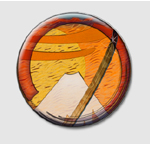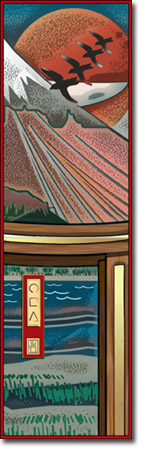On The Way: The Daily Zen Journal
Guidelines for Studying the Way
Dogen (1200-1253)
What you should know for practicing Zen
Practicing Zen, studying the way, is the great matter of a lifetime. You should not belittle it or be hasty with it. A master of old cut off his arm and another cut off his fingers. These are excellent models from China. Long ago Shakyamuni Buddha abandoned his home and left his country. This is an excellent precedent for practicing the way.
People of the present say you should practice what is easy to practice. These words are quite mistaken. They are not at all in accord with the buddha way. If this alone is what you regard as practice, then even lying down will be wearisome. If you find one thing wearisome, you will find everything wearisome. It is obvious that people who are fond of easy practice are not capable of the way.
In fact, the dharma spread and is present in the world because our great teacher Shakyamuni practiced with difficulty and pain for immeasurable eons and finally attained this dharma. If the original source is like this, how could the later streams be easy?
Students who would like to study the way must not wish for easy practice. If you seek easy practice, you will for certain never reach the ground of truth or dig down to the place of treasure. Even teachers of old who had great capacity said that practice is difficult. You should know that the buddha way is vast and profound.

If the buddha way were originally easy to practice, then teachers of great capacity from olden times would not have said that practice is difficult and understanding is difficult. Compared with the people of old, those of today do not amount to even one hair from nine cows. With their small capacity and shallow knowledge, even if people of today strive diligently and regard this as difficult and excellent practice, still it does not amount to even the easiest practice and easiest understanding of the teachers of old.
What is this teaching of easy understanding and easy practice, which people nowadays like? It is neither a secular teaching nor Buddha’s teaching. It does not come up to the practice of Papiyas, the Demon King, nor does it come up to the practice of those outside the way or of the Two Lesser Vehicles. We should regard it as the product of ordinary people’s extreme delusion. Even though they try to attain liberation, they find nothing but endless rounds of suffering.
On the other hand, we can see that breaking bones or crushing marrow is not difficult, but to harmonize the mind is most difficult. Again, the practice of prolonged austerities is not difficult, but to harmonize bodily activities is most difficult.
Do you think crushing bones is of value? Although many endured such practice, few of them attained dharma. Do you think people practicing austerities are to be respected? Although there have been many, few of them have realized the way, for they still have difficulty harmonizing the mind.
Brilliance is not primary, understanding is not primary, conscious endeavor is not primary, introspection is not primary. Without using any of these, harmonize body-and-mind and enter the buddha way.
Old man Shakyamuni said, “Avalokiteshavara turns the stream inward and disregards knowing objects.”
That is the meaning. Separation between the two aspects of activity and stillness simply does not arise. This is harmonizing.
If anyone could enter the buddha way by means of brilliance or broad knowledge, then the senior monk Shenxiu would have been the one. If anyone of ordinary appearance or humble position were excluded from the buddha way, how could Huineng become the Sixth Ancestor? It is clear that the buddha way’s transmission lies outside brilliance and broad knowledge. Search and find out. Reflect and practice.
Being old or decrepit does not exclude you. Being quite young or in your prime does not exclude you. Although Zhaozhou first studied when he was over sixty, he became a man of excellence in the ancestral lineage. Zheng’s daughter had already studied long by the time she was thirteen, and she was outstanding in the monastery. The power of buddha-dharma is revealed depending on whether or not there is effort, and is distinguished depending on whether or not it is practiced.
Those who have studied sutras a long time and those who are accomplished in secular texts, all should study at a Zen monastery. There have been many examples of this. Huisi of Nanyue was a very learned man, but still he practiced with Bodhidharma. Xuanjue of Yongjia was an excellent scholar, and still he practiced with Dajian.
When you practice with a teacher and inquire about dharma, clear body and mind, still the eyes and ears, and just listen and accept the teaching without mixing in any other thoughts. Your body and mind will be one, a receptacle ready to be filled with water. Then you will certainly receive the teaching.
Nowadays, there are foolish people who memorize words of texts or accumulate sayings and try to match these words with the teacher’s explanation. In this case they have only their own views and old words, and have not yet merged with the teacher’s words.
For some people their own views are primary; they open a sutra, memorize a word or two, and consider this to be buddha-dharma. Later when they visit with an awakened teacher or a skilled master and hear the teachings, if it agrees with their own view they consider the teaching right, and if it does not agree with their old fixed standards they consider his words wrong. They do not know how to abandon their mistaken tendencies, so how could they ascend and return to the true way? For ages numberless as particles of dust and sand, they will remain deluded. It is most pitiable. Is it not sad?
Students should know that the buddha way lies outside thinking, analysis, prophecy, introspection, knowledge, and wise explanation. If the buddha way were in these activities, why would you not have realized the buddha way by now, since from birth you have perpetually been in the midst of these activities?
Students of the way should not employ thinking, analysis, or any such thing. Though thinking and other activities perpetually beset you, if you examine them as you go, your clarity will be like a mirror.
Practice throughout the way
To practice throughout the way is to actualize the limitless realm of the buddha way and to illuminate all aspects of the buddha way. The buddha way is under everyone’s heel. Immersed in enlightenment, you are complete. Therefore, even though you arrive at full understanding, still this is only a part of enlightenment. This is how it is with practice throughout the way.
People nowadays who study the way do not understand where the way leads or ends, so they strongly desire to gain visible results. Who would not make this mistake? It is like someone who runs away from his father, leaving a treasure behind and wandering about. Though he is the only child of a wealthy family, he endlessly wanders as a menial in foreign lands. Indeed it is just like this.
Those who study the way seek to be immersed in the way. For those who are immersed in the way, all traces of enlightenment perish. Those who practice the buddha way should first of all trust in the buddha way. Those who trust in the buddha way should trust that they are in essence within the buddha way, where there is no delusion, no false thinking, no increase or decrease, and no mistake. To arouse such trust and illuminate the way in this manner, and to practice accordingly, are fundamental to studying the way.
You do this by sitting, which severs the root of thinking and blocks access to the road of intellectual understanding. This is an excellent means to arouse true beginner’s mind. Then you let body and mind drop away and let go of delusion and enlightenment. This is the second aspect of studying the way.Generally speaking, those who trust that they are within the buddha way are most rare. If you have correct trust that you are within the buddha way, you understand where the great way leads or ends, and you know the original source of delusion and enlightenment. If once, in sitting, you sever the root of thinking, in eight or nine cases out of ten you will immediately attain understanding of the way.
Immediately hitting the mark
There are two ways to penetrate body and mind: studying with a master to hear the teaching, and devotedly sitting zazen. Listening to the teaching opens up your conscious mind, while sitting zazen is concerned with practice-enlightenment.
Everyone has a body-mind. In activity and appearance its function is either leading or following, courageous or cowardly. To realize buddha immediately with this body-mind is to hit the mark. Without changing your usual body-mind, just to follow buddha’s realization is called “immediate,” is called “hitting the mark.”
To follow buddha completely means you do not have your old views. To hit the mark completely means you have no new nest in which to settle.
Dogen (1200-1253)
Excerpted from Moon in a Dewdrop – Writings of Zen Master Dogen, edited by Kazuaki Tanahashi




I often marvel at how contemporary the ancient writings sound. You can see how students of all ages fell into the same pitfalls of practice we do. Teachers always seem to talk about students of “today” not having the same intensity or commitment to difficult practice. There must have always been people talking about an easy path, a short cut, a revolutionary 3 Steps to Enlightenment method; hence the need to step back and ask ourselves, if it were all really that easy, then why aren’t more people living an enlightened life?
Then there is also the admonishment given that to really study one needs to find an awakened teacher to transmit the teachings. Let’s remember the Buddha’s story. He had no awakened master to go study with; he sat under the Bodhi tree in meditation and struggled with Mara and his own mental distractions until he broke through. The greatest function of a teacher or a spiritual friend is to honestly point out when we stray off track, when we are fooling ourselves, an extremely difficult task to do for oneself.
However, reality is that many people have not found an awakened master to trust their spiritual training to. So in this real world, where for many people, there are not the funds nor time to go hunting all over the world to find this person, what do we do? Even though the purist may take issue with our approach, we are left with studying as best we can with these masters of old, tried and true, to guide us. The difference is there is no one going around correcting our posture in meditation or striking us if we fall asleep on the mat; there is no Master to have a spiritual encounter with to challenge us, and that IS the crux of our situation. We can so easily fool ourselves in complacency.
Who will wake us up? Zen Master Zuigon had his own unique approach:
Every day Zuigan used to call out to himself, “Master!” and would answer, “Yes!”
Then he would tell himself, “Wake up!” and he would answer himself, “Yes! Yes!”
Then he would say to himself, “Don’t be deceived by others, any day or any time!”
and he would again answer himself, “Yes, yes!”
What creative approach will we find to wake ourselves up?
Waking up once again,
Elana